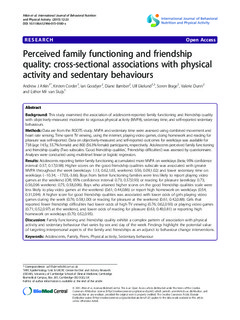| dc.contributor.author | Atkin, Andrew J. | |
| dc.contributor.author | Corder, Kirsten | |
| dc.contributor.author | Goodyer, Ian M. | |
| dc.contributor.author | Bamber, Diane J | |
| dc.contributor.author | Ekelund, Ulf | |
| dc.contributor.author | Brage, Søren | |
| dc.contributor.author | Dunn, Valerie J. | |
| dc.contributor.author | van Sluijs, Esther M.F. | |
| dc.date.accessioned | 2016-04-06T07:23:59Z | |
| dc.date.available | 2016-04-06T07:23:59Z | |
| dc.date.issued | 2015-02-21 | |
| dc.identifier.citation | International Journal of Behavioral Nutrition and Physical Activity. 2015, 12, 23. doi:10.1186/s12966-015-0180-x | nb_NO |
| dc.identifier.uri | http://hdl.handle.net/11250/2384087 | |
| dc.description | © Atkin et al.; licensee BioMed Central. 2015
This is an Open Access article distributed under the terms of the Creative Commons Attribution License (http://creativecommons.org/licenses/by/4.0), which permits unrestricted use, distribution, and reproduction in any medium, provided the original work is properly credited. The Creative Commons Public Domain Dedication waiver (http://creativecommons.org/publicdomain/zero/1.0/) applies to the data made available in this article, unless otherwise stated. | nb_NO |
| dc.description.abstract | Background:
This study examined the association of adolescent-reported family functioning and friendship quality with objectively-measured moderate to vigorous physical activity (MVPA), sedentary time, and self-reported sedentary behaviours.
Methods:
Data are from the ROOTS study. MVPA and sedentary time were assessed using combined movement and heart rate sensing. Time spent TV viewing, using the internet, playing video games, doing homework and reading for pleasure was self-reported. Data on objectively-measured and self-reported outcomes for weekdays was available for 738 (age 14.5y, 55.7% female) and 800 (56.3% female) participants, respectively. Adolescents perceived family functioning and friendship quality (Two subscales: ‘Good friendship qualities’, ‘Friendship difficulties’) was assessed by questionnaire. Analyses were conducted using multi-level linear or logistic regression.
Results:
Adolescents reporting better family functioning accumulated more MVPA on weekdays (beta; 95% confidence interval: 0.57; 0.17,0.98). Higher scores on the good friendship qualities subscale was associated with greater MVPA throughout the week (weekdays: 1.13; 0.62,1.65, weekend: 0.56; 0.09,1.02) and lower sedentary time on weekdays (−10.34; −17.03,-3.66). Boys from better functioning families were less likely to report playing video games at the weekend (OR; 95% confidence interval: 0.73; 0.57,0.93) or reading for pleasure (weekday: 0.73; 0.56,0.96 weekend: 0.75; 0.58,0.96). Boys who attained higher scores on the good friendship qualities scale were less likely to play video games at the weekend (0.61; 0.44,0.86) or report high homework on weekdays (0.54; 0.31,0.94). A higher score for good friendship qualities was associated with lower odds of girls playing video games during the week (0.76; 0.58,1.00) or reading for pleasure at the weekend (0.61; 0.42,0.88). Girls that reported fewer friendship difficulties had lower odds of high TV viewing (0.76; 0.62,0.93) or playing video games (0.71; 0.52,0.97) at the weekend, and lower odds of reading for pleasure (0.63; 0.49,0.81) or reporting high homework on weekdays (0.70; 0.52,0.95).
Discussion:
Family functioning and friendship quality exhibit a complex pattern of association with physical activity and sedentary behaviour that varies by sex and day of the week. Findings highlight the potential value of targeting interpersonal aspects of the family and friendships as an adjunct to behaviour change interventions. | nb_NO |
| dc.language.iso | eng | nb_NO |
| dc.publisher | BioMed Central | nb_NO |
| dc.subject | adolescents | nb_NO |
| dc.subject | family | nb_NO |
| dc.subject | peers | nb_NO |
| dc.subject | physical activity | nb_NO |
| dc.subject | sedentary behaviour | nb_NO |
| dc.title | Perceived family functioning and friendship quality: cross-sectional associations with physical activity and sedentary behaviours | nb_NO |
| dc.type | Journal article | nb_NO |
| dc.type | Peer reviewed | nb_NO |
| dc.subject.nsi | VDP::Social science: 200 | nb_NO |
| dc.subject.nsi | VDP::Social science: 200::Social science in sports: 330 | nb_NO |
| dc.subject.nsi | VDP::Medical disciplines: 700 | nb_NO |
| dc.subject.nsi | VDP::Medical disciplines: 700::Sports medicine: 850 | nb_NO |
| dc.source.journal | International Journal of Behavioral Nutrition and Physical Activity | nb_NO |
| dc.description.localcode | Seksjon for idrettsmedisinske fag / Department of Sports Medicine | nb_NO |
